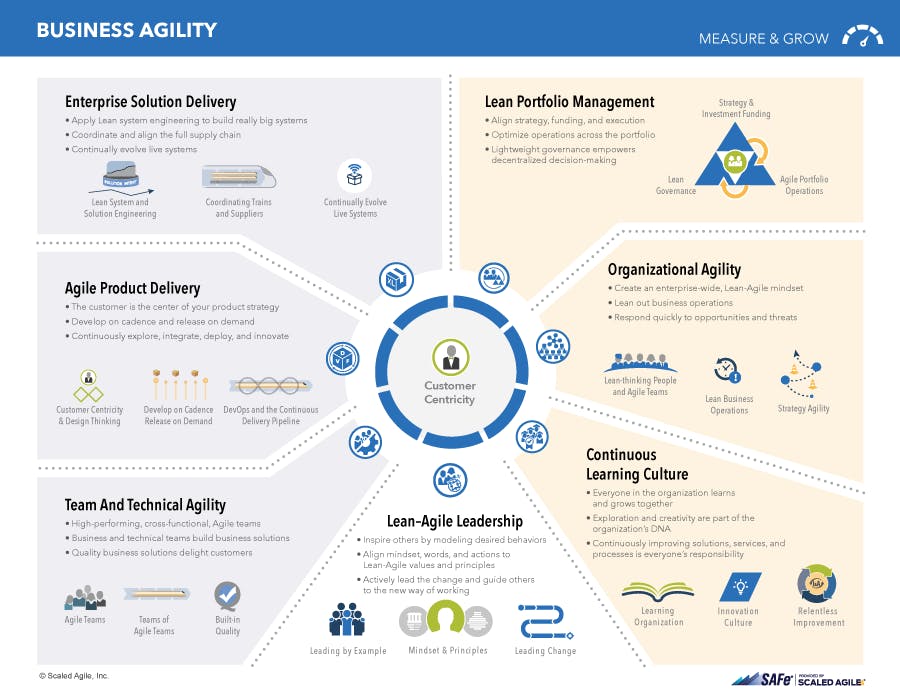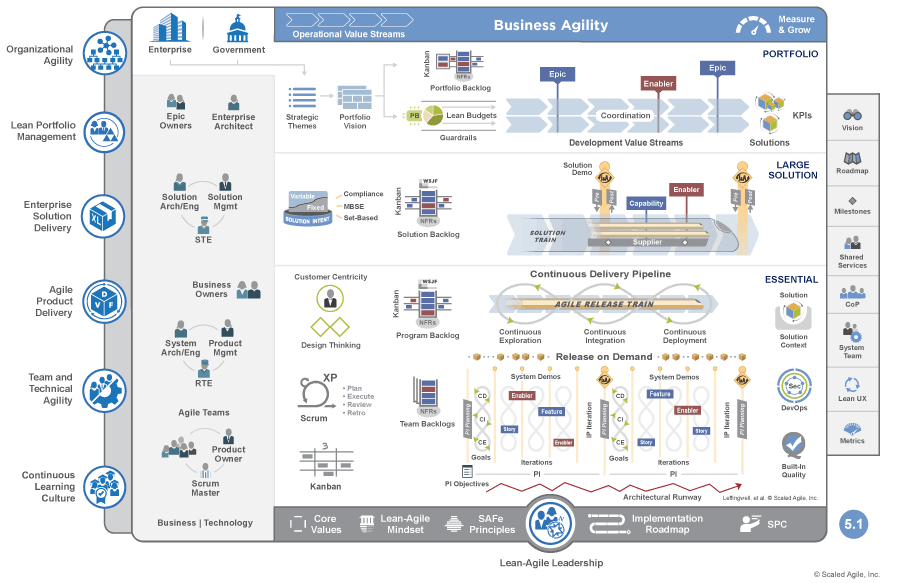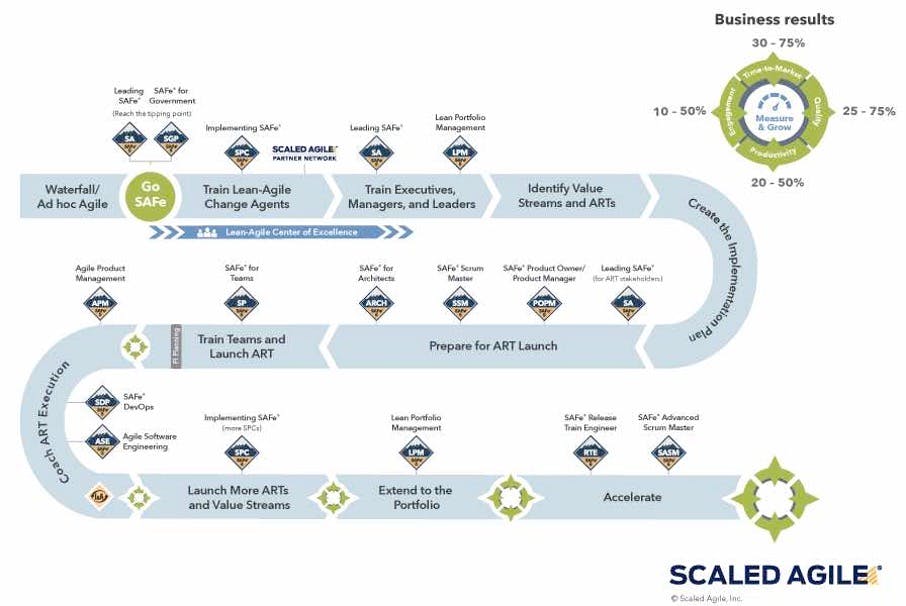Today, digital transformation and Lean-Agile ways of working are key for complex organizations to become – and remain – successful in a highly volatile and competitive global market. At some point in time, you’ll need to think about Scaling Agile to ensure that your whole organization can benefit from the wonders of Agile. While there are several well-known Agile Scaling frameworks, the Scaled Agile Framework, or SAFe, is surely one of the most widely adopted frameworks.
But what is SAFe and what are the benefits of adopting SAFe? We’ll tell you all about it in this article!
1. What is SAFe?
2. What are its core values?
3. What is an ART?
4. What are the four levels of SAFe?
5. Why (be) SAFe?
6. What makes SAFe so popular?
7. What are the biggest advantages of the SAFe approach?
8. How do I implement SAFe?
9. Is SAFe suitable for my organization?
10. Which SAFe training courses and certifications does Scaled Agile offer?
1. What is SAFe?
How do you still apply the principles of Lean-Agile in a growing, more complex organizational structure and on a much larger scale? By mastering and internalizing the Scaled Agile Framework (SAFe)!
SAFe is a framework for organizations in which many teams work on multiple complex products in an ever-changing environment. The SAFe framework enables organizations to respond quickly to change, efficiently recognize customer needs, and increase the quality of fluidly evolving products.
SAFe promotes collaboration and constant value delivery across large(r) numbers of Agile teams. The framework aligns structure, strategy, and execution of software- and systems-developing organizations, to increase product value, quality, predictability, and efficiency.
SAFe ‘safeguards’ competitiveness through speedy innovation (hence the complementing ‘e’), and bolsters instant adaptation to extremely volatile market environments.
2. What are its core values?
SAFe is a scaling method that combines the principles of Scrum, Lean, Kanban, and DevOps, making your organization as Agile as you need it to be.
The following ‘agility tactics’ define the four core values of SAFe:
1. Alignment
Organizations that are not aligned internally might have difficulties with making decisions and responding to unexpected changes. Aligned organizations are Agile; they can adapt quickly and deal with the unforeseen.
2. Built-in Quality
Product quality must be built and monitored during all stages of the process, not just added later after inspection.
3. Transparency
In SAFe, transparency is most important, because without it, facts are just opinions and decisions will be made based on gut feeling. Obviously, that won’t do your product any good.
4. Program Execution
With SAFe, process execution and the actual production is crucial as value needs to be delivered on a constant basis. With Agile teams and an Agile Release Train (ART) guaranteeing program execution, the work gets done.
3. What is an ART?
ART refers to the Agile Release Train and is a critical element of the SAFe Framework.
The Agile Release Train (ART) is a long-lived group of Agile teams, which, along with other stakeholders, incrementally develops, delivers, and where applicable, operates one or more solutions in a value stream.
Each ART consists of multiple Agile teams. Together, they form a virtual organization (5 to 12 teams, 5 to 9 people each) that plans, commits, and executes in an aligned way. An ART consists of at least 50 people but is more likely to contain up to 125 to 150 people (Dunbar’s Number).
A Release Train Engineer, Scrum Masters, Product Management, and Product Owners support each ART. The goal of the ART is to deliver partial products together with other stakeholders in a series of Sprints (so-called Program Increments).
An overview of ART’s continuous flow of value:
4. What are the four levels of SAFe?
SAFe 5.1 is the most recent version of the SAFe Framework. It comprises 4 incremental configurations or ‘levels’ of SAFe, consisting of 7 customer-centric Core Competencies of the Lean Enterprise:
Level 1: Essential SAFe
The most basic configuration; the critical elements of SAFe, including:
- Lean Agile Leadership - the foundation of SAFe, for the empowerment of individuals and teams to reach their highest potential.
- Team and Technical Agility - for increased productivity, better quality, faster time-to-market (TTM), and predictable delivery of value.
- Agile Product Delivery - DevOps and Release on Demand, a continuous delivery pipeline for batches of high-value functionalities and solutions, lower development costs, and reduced risk, while staying competitive.
Level 2: Large Solution SAFe
For coordination and synchronization across multiple programs, with:
- Enterprise Solution Delivery - a Lean-Agile approach that optimizes the development, deployment, and evolution of large, complex software applications in cyber-physical systems (also called ‘Large Solution SAFe’).
Level 3: Portfolio SAFe
Includes strategy, funding, and Lean governance through:
- Organizational Agility - to optimize business processes, evolve strategy through commitments, and adapt quickly for the capitalization of new market opportunities.
- Lean Portfolio Management – to align portfolio strategy, funding, operations, and governance.
Level 4: Full SAFe
All of the above combined, plus:
- Continuous Learning Culture - for the steady increase in knowledge, competence, performance, and innovation.

Organizations that master these Core Competencies are able to build the essential muscle memory and mindset that thrive future successes.
Full SAFe at a glance:

For a full overview of the complete Framework and its Core Competencies, have a look here.
5. Why (be) SAFe?
Organizations have to embrace a more fluid way of working to stay competitive. They are forced to work in an effective manner – one that allows for new technologies to be assessed, tested, analyzed, and acted upon as quickly as possible: fail fast, succeed faster.
But all that requires a fundamental shift in work culture and organizational behavior. That shift is SAFe. So, what are the benefits of SAFe?
Choosing for SAFe allows you:
- To align technology development with strategic business goals.
- To deliver new value on a predictable basis.
- To improve solution quality and meet customer demand.
- To scale Agile team practices to ARTs (Agile Release Trains) and across value streams.
- To create a collaborative, innovative, and continuously improving the working environment.
- To organize people and teams around value creation and reduce delays.
- To install a culture that allows failure and encourages people to take risks, think creatively, and embrace continuous learning.
And according to Scaled Agile, organizations that adopt SAFe experience a:
- 20 – 50% increase in productivity.
- 25 – 75% improvements in quality.
- 30 – 75% faster time-to-market.
- 10 – 50% increase in employee engagement and job satisfaction.
6. What makes this Agile Scaling framework so popular?
SAFe maximizes the ability of complex organizations to deliver the best solution value in the shortest sustainable time.
SAFe organizations…
- Are transparent.
- Learn continuously.
- Predict and plan better.
- Update and iterate quickly.
- Release often.
- Minimize waste of time and effort.
- Make smart decisions on what to develop next.
It helps you focus on scaled Agile team-working systems and business outcomes, making enterprises more reliable and efficient in a transparent, structured manner.
THAT is why SAFe is so popular. But more importantly: it’s motivating!
7. What are the biggest advantages of SAFe?
The top 5 advantages of SAFe are:
- Better business results & increase in productivity (20-50%).
- Quality improvement (25-75%).
- Faster time-to-market (30-75%).
- Increased predictability & planning.
- Higher employee engagement & job satisfaction (10-50%).
All these advantages are top business requirements in a volatile market environment that’s subject to non-stop technological acceleration and constantly changing customer demands and needs.
8. How do I implement SAFe?
SAFe is based upon 10 basic concepts derived from the Lean & Agile principles of the Agile Manifesto. Translated, these principles lead the way.
The organizational adoption of SAFe requires the following:
- Take an economic view.
- Apply systems thinking.
- Assume variability; preserve options.
- Build incrementally with fast integrated learning cycles.
- Base milestones on an objective evaluation of working systems.
- Visualize and limit work-in-progress, reduce batch sizes, and manage queue lengths.
- Apply cadence (timing), and synchronize with cross-domain planning.
- Unlock the intrinsic motivation of knowledge workers.
- Decentralize decision-making.
- Organize around value.
To reach this adoptive mindset, Scaled Agile has developed a roadmap for implementation, comprising 12 steps:
- Reaching the Tipping Point.
- Train Lean-Agile Change Agents.
- Train Executives, Managers, and Leaders.
- Create a Lean-Agile Center of Excellence.
- Identify Value Streams and ARTs.
- Create the Implementation Plan.
- Prepare for ART Launch.
- Train Teams and Launch the ART Coach.
- ART Execution.
- Launch More ARTs and Value Streams.
- Extend to the Portfolio.
- Accelerate.

9. Is SAFe suitable for my organization?
Small organizations with, for example, only one product (group) are perfectly fine with working Agile by implementing one or a small number of Scrum teams and Product Owners.
But as soon as your organization reaches a stage where complexity causes…
- More abstract responsibilities and delegated authority.
- Longer planning horizons.
- A growing need for the synchronization of deliverables.
- More time-consuming innovation and planning.
…then you’ll definitely have to scale beyond a single team and resort to better-scaled ways of Lean-Agile working, such as the SAFe Framework.
So better ask the other way around: is your organization in need of scaling Agile processes? Then yes, SAFe is definitely suitable for you!
10. Which SAFe training courses and certifications can I get?
As a certified SAFe Professional, you are in great company. Over half a million individuals worldwide – such as Agile Coaches, Business Analysts, System & Solution Architects, Portfolio Managers, Product Owners, and CEOs – have already engaged in Scaled Agile training to help their organizations and teams transition to the new way of working.
Which certification course should you take? That depends on your current role and the reason why you wish to enhance that role. Whether you are a Scrum Master wishing to become a SAFe 5 Scrum Master (SSM), an agile team leader looking to become Certified Leading SAFe, or a Product Owner aiming at becoming a Certified SAFe 5 Product Owner/Product Manager (SAFe PO/PM), we have all the right courses in the house.
As a Gold Partner of Scaled Agile, we offer tailored, world-class SAFe certification training courses.
To find the best SAFe course for your position, check all the SAFe courses we offer over here.
Happy learning!





